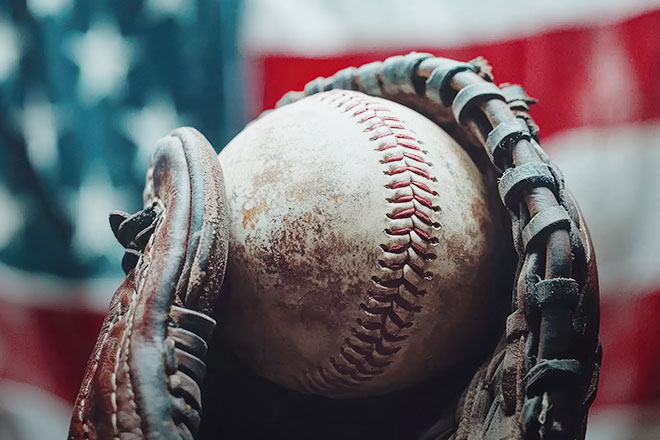As we welcome Independence Day celebrations, most Americans think of iconic American imagery — often hot dogs, burgers, summer nights, and baseball! The oldest American sport often recalls childhood memories of a slow, strategic game steeped in tradition. Take another look, however, as Major League Baseball (MLB) is going through a strategic transformation from “America’s Pastime” heritage-based position to a modern and globally competitive brand. This shift is worth looking into to show how repositioning is oftentimes required even for the most iconic of brands. And it’s also a good sports marketing strategy.
America’s Pastime Falls Behind
Baseball’s long-standing position against competitor sports leagues has almost always been its “heritage.” While professional baseball has been around for well over a century, the sport has been losing to its competitors for the better part of the last 30 years. Other than one brief comeback during the steroid-era glamor of the late 90s, even some of the most passionate baseball fans could sense that the game was nearing its end in the limelight as average viewership for the World Series had dropped from over 30 million in late 80s, to less than 10 million starting in the 2010s. At the onset of the fast-paced internet age, MLB failed to keep up with the subsequent fast-paced environment that the NFL and NBA dominated, and the sport began to wither as its fan base aged. The league’s management has undoubtedly felt pressure to take drastic action in its sports marketing strategy to change baseball’s downward momentum.
Not Your Grandfather’s Sports Marketing Strategy
MLB has addressed this issue with authority. Rather than shrugging off the low ratings with more promotions and marketing spend on the same old baseball of the 20th century, MLB underwent a massive long-term repositioning effort that has begun to pay dividends the last few years. In 2015, Rob Manfred was elected by team owners as the tenth commissioner of Baseball, the CEO of MLB who guides any decision-making of the league in umpiring, labor, marketing, and television contracts. Manfred made one thing clear: under him, baseball was going to change.
Implementing massive baseball rule changes in 2015, 2017, 2020, and 2023, the pace of the game quickened and winning prioritized viral highlights of offensive power. However, rule changes are only the most obvious aspects of the league’s efforts. The league has continued to encourage massive contracts focused on major stars of the game by shutting down salary cap standards, leading to nearly 1-billion-dollar contracts with world-famous players. One of these players, Japan-native Shohei Ohtani, was thrust into the spotlight as the face of the game as a part of another initiative to increase global outreach that included periods of international signing pressure, merchandising abroad, and World Baseball Classic tournaments. While all these changes seem relatively minor in a vacuum, they’ve culminated in what can only be described as the first major repositioning effort by a Big Four sports league. Organization-wide commitment is one of the most necessary pieces of building and maintaining an organization’s position, and it falls on the CEO to defend this commitment. Manfred has fulfilled this role emphatically, ensuring that every facet of MLB has been reoriented towards a new position, rather than banking on its existing sports marketing strategy. MLB has broken out of its historic position of heritage as America’s pastime and broken into a position of the #2 international sport.
Japan Comes Out to Play, And Watch!
Last month, my wife and I traveled to Japan and chose a fun time-killer while waiting for transportation: pointing out our favorite advertisements. However, it didn’t take long for us to notice the one recurring face, no matter where we looked. From subway signs to billboards and almost every vending machine, Shohei Ohtani is the face of Japanese marketing. It didn’t stop with just traditional marketing; we found the morning news shows broadcasting Los Angeles Dodgers games live, with Japanese celebrities reacting to the latest stories of Japanese baseball players in the United States. MLB has more than tripled its audience since 2020 — Japanese viewership nearly matched that of the domestic audience of the 2024 World Series and 2025 season opener. Japan is just one of the biggest examples among many. The MLB estimates that over half of households in Latin America follow baseball, that upwards of 20 million Chinese MLB fans connect with the sport from Chinese broadcasting services, all while promoting Korean and Taiwanese national leagues that have fed into MLB recruitment. Even some European countries containing the most loyal soccer cultures estimate that millions of their own follow baseball with a devout fanbase, such as Germany, France, and the Netherlands. MLB hasn’t just established a simple international presence; they’ve built a loyal international following.
As international signing encouragement has built a league comprised of players from Australia to Lithuania, MLB presents a #2 position that works harder to connect with fans by ensuring nobody is barred from participating. This has worked spectacularly as over 30 nations have put together national teams for the World Baseball Classic, including several European nations, to help baseball close in on the 48 nations in The World Cup. In conjunction with a modified style of gameplay, this international following has helped MLB craft a new identity that allows new marketing campaigns to support long-term success rather than cash in on cheap short-term wins.
Positioned to Win the Next Generation
A quickly aging fan base defined one of the largest struggles plaguing baseball prior to 2020. Even if baseball can become a sport with an international audience and a new style of play, the league needs to grab the attention of the younger audience that these changes targeted to capitalize on a new position. Manfred’s team put a bow on their sports marketing strategy by introducing an excellent new campaign.
The MLB’s 2025 campaign, “Heroes Of The Game,” perfectly represents how a campaign is executed to continue its repositioning effort. This campaign uses a series of short-form videos, popular on platforms such as TikTok and Instagram, that display MLB players as anime-style characters competing for their shot to become a “hero” of baseball. The MLB does a lot of things right here; they target both their growing international audience and a new youth audience simultaneously through a beloved creative style for both groups. With short-form video, they also use media that is accessible to fans globally, continuing the trend of positioning the game as a fan-connected alternative to soccer. This campaign continues to delight audiences with the faces of the sport. It’s an excellent combination of young hotshots that display baseball’s style and stage presence with world-famous veterans, like Ohtani, who display historic highlights and records. With the MLB using the last few years to move past its heritage as a slow-paced strategy game and forward as a fast-paced sport through massive organizational change, this campaign feels perfectly fresh without seeming inappropriate for the game audiences know.
Repositioning: The Right Sports Marketing Strategy?
There are multiple ways to determine the success of a repositioning strategy for a sport, and the MLB prioritizes three major numbers: viewership ratings, revenue, and youth participation. As I previously mentioned, viewership ratings have seen growth in ways the sport has never seen before, with a quickly growing domestic audience only representing a small fraction of the massive, loyal international fanbase. Similarly, the league’s total revenue has seen a massive jump in the post-COVID period, with a new revenue record set every year starting in 2022 as the expansion of digital subscriptions and fan attendance explode.
There is one important statistic that sets sports leagues apart from traditional organizations, as it determines their longevity and future success: youth participation in the sport. The more sports leagues see young people playing their sport, the more those sports leagues will stand to grow presently and in the future, both in fan base and competition. After all, the declining youth participation in baseball was a major factor spurring a repositioning of the league in the first place. The good news for MLB is that baseball is more popular with kids than ever before, experiencing nearly 10% growth annually in both 2022 and 2023. It nears twenty million youth baseball players in the U.S. alone. When combining all three statistics, it's clear that MLB didn’t just successfully reposition itself as an organization, but the game of baseball as a whole.
A New Kind of Baseball
MLB has made it clear that baseball will be around to stay and shows that legacy brands can reposition with success. Even if the familiar term “America’s pastime” has long since passed — the evolution to a global youth-driven entertainment brand will keep the relevance MLB needs to reach the next generation of sports fans. True, it may not be your grandfather’s baseball, but you can expect to continue hearing that familiar crack of the bat well into the future.
If your brand is facing a challenge like what MLB faced, contact America’s #1 positioning ad agency to help find the best brand strategy that works for your organization.



